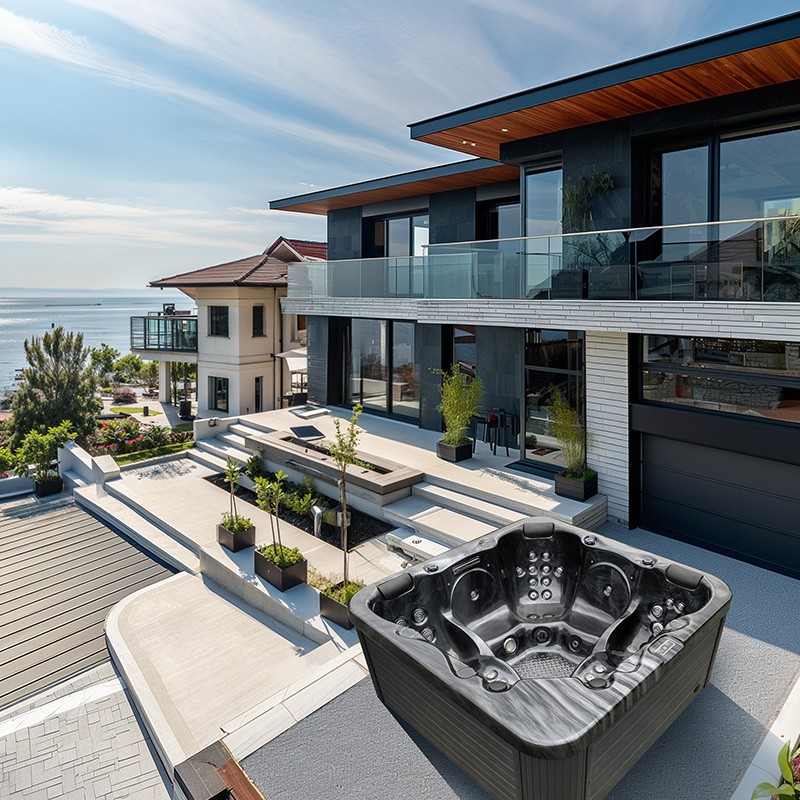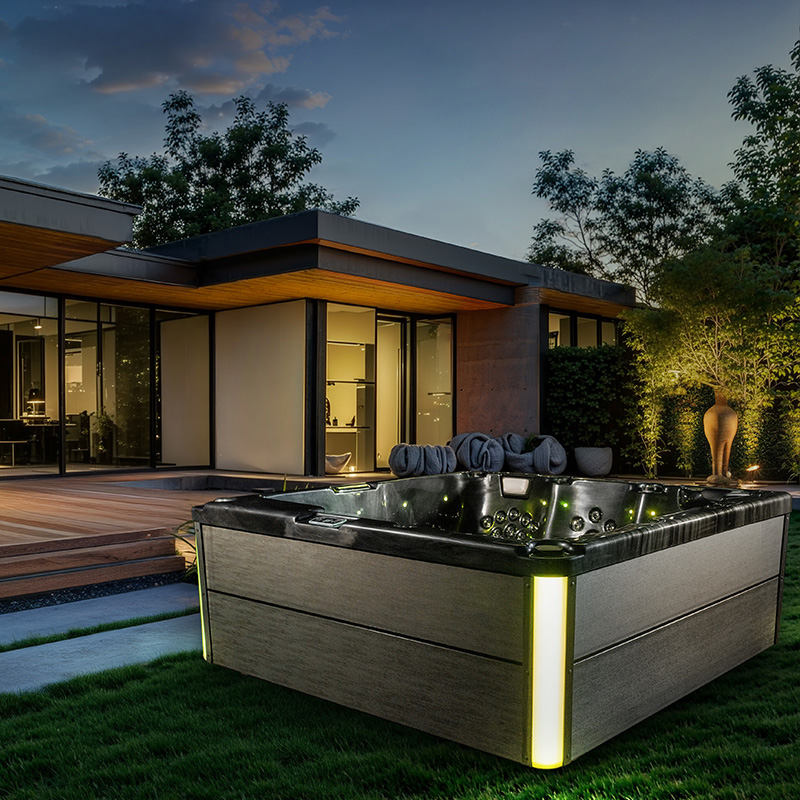
How to conceal the plumbing of a freestanding whirlpool bathtub?
2025-08-13 15:35Freestanding whirlpool bathtubs are popular among consumers for their freestanding, free-standing design. They not only provide a deeply relaxing hydrotherapy experience but also serve as a unique decorative element in the bathroom.
With the popularity of these bathtubs, many users are faced with the challenge of how to address the issue of exposed plumbing. Exposed plumbing not only affects the aesthetics of the bathtub but can also pose a safety hazard. Therefore, how to cleverly conceal the plumbing of a freestanding whirlpool bathtub has become a concern for many consumers.
This article will analyze various methods for concealing the plumbing of a freestanding whirlpool bathtub from multiple perspectives, exploring the necessity, design principles, and implementation options. This approach will help users ensure the functionality of the bathtub while enhancing the overall aesthetics of the bathroom.
What is the plumbing system of a freestanding whirlpool bathtub?
A whirlpool bathtub generally includes water supply pipes, drainage pipes, air flow pipes, and a system of pipes connected to components such as the pump, heater, and filter. These pipes are responsible for directing water into and out of the bathtub, providing power for the jets, and ensuring the proper operation of the system.
1. Water Pipes
The water pipes typically connect to the bathtub's multiple jets. A water pump pressurizes water and delivers it to the jets, creating a water massage. The water pipes are typically thick to ensure adequate water flow.
2. Airflow Pipes
The airflow pipes connect to the bathtub's aeration jets and are typically thinner. An air pump pumps air into the pipes, creating the bubbling effect. The airflow pipes often work in conjunction with the water pipes to provide a different massage experience.
3. Drain Pipes
The drain pipes are responsible for draining wastewater from a freestanding whirlpool bathtub. They typically have dedicated drain outlets and drain water via a drain pump or gravity. To ensure smooth drainage, the design of this part of the pipe is typically simple and straightforward.
4. Electrical and Control Systems
In addition to water and airflow pipes, a freestanding whirlpool bathtub also requires electrical wiring to control functions such as the water pump, heater, and massage modes. While these wires and cables are typically concealed, they must still be routed carefully to avoid exposed plumbing and safety hazards.
What are the implications of exposed pipes in a freestanding whirlpool bathtub?
While freestanding whirlpool bathtubs offer a beautiful and modern design, their exposed pipes often significantly diminish the overall visual appeal. Exposed pipes not only detract from the bathtub's aesthetics but can also cause several practical problems:
1. Aesthetic Impact
Pipes are often made of metal or plastic and feature a monochromatic color. This can detract from the elegant feel of a freestanding whirlpool bathtub, making it appear out of place, especially if it doesn't blend in with the surrounding bathroom decor. This diminishes the bathtub's aesthetics and can make the entire bathroom appear cluttered.
2. Dust and Dirt Accumulation
Exposed pipes easily accumulate dust and dirt, especially in humid environments, where mold can grow on the pipes. This not only affects bathroom hygiene but also makes cleaning more difficult.
3. Safety Hazards
Exposed pipes, outlets, and electrical wiring can pose a safety hazard to family members, especially children. High-voltage electrical wiring can pose a risk of electric shock, and exposed pipes, if not properly handled, can become a source of tripping hazards, cuts, and other injuries.
4. Damage to Pipes and Fixtures
Exposed pipes are susceptible to physical damage, such as impact and friction, which can cause pipe degradation, cracking, or leaks, affecting the proper functioning of a freestanding whirlpool bathtub. Pipes left uncovered for extended periods are also susceptible to external factors, such as UV rays and temperature and humidity fluctuations, shortening their lifespan.
How to conceal the pipes of a freestanding whirlpool bathtub?
Concealing the pipes of a freestanding whirlpool bathtub not only enhances the aesthetics of your bathroom but also reduces damage and cleaning difficulties. Here are several common design options and methods for concealing pipes:
1. Custom Bathtub Enclosures
Customizing a bathtub enclosure or panel is one of the most common ways to conceal pipes. Enclosures are typically made of stainless steel, wood, plastic, or ceramic and can be customized to suit the bathtub's shape and overall bathroom design. Enclosures are typically installed with magnets, hinges, or slides, allowing for easy removal and maintenance. This design effectively conceals the pipes while providing convenient access for repairs or inspections.
· Advantages: Aesthetically pleasing, customizable, and easy to maintain.
· Disadvantages: Custom installation requires time and budget.
2. Installing Decorative Panels
If you don't want to completely hide the plumbing, you can also install decorative panels. These panels simply cover the plumbing beneath the tub, similar in appearance to regular bathroom vanities or decorative panels. Decorative panels are typically minimalist but can add a touch of sophistication to the tub and, with the right color, texture, and material, blend in with the overall bathroom decor.
· Pros: Highly decorative and easy to install.
· Disadvantages: May not be as discreet as custom covers, and panels are difficult to remove.
3. Concealing Plumbing in Built-in Space Under the Tub
Some freestanding whirlpool bathtubs have built-in storage or compartments that can be used to conceal the plumbing and pump system. This design not only maintains a clean appearance but also improves bathroom space utilization.
· Pros: Perfectly conceals plumbing, keeping the bathroom tidy.
· Disadvantages: Requires advanced planning and may affect the whirlpool base structure and pump placement.
4. Concealing pipes on the wall or floor
During the bathroom renovation phase, users can also conceal pipes through wall or floor renovations. With clever layout, burying pipes within the wall or underground plumbing system not only effectively conceals them but also enhances the bathroom's tidiness.
For example, creating a hidden plumbing channel within the wall allows the pipes to extend from the whirlpool bathtub to the ground or another hidden location, without affecting the bathroom's aesthetics. This approach not only conceals the pipes but also ensures a clean and tidy bathroom space.
· Advantages: Completely concealed, no impact on the appearance.
· Disadvantages: Requires high construction costs and precise design.
5. Concealing with a bathtub enclosure or wall
If the freestanding whirlpool bathtub is in a fixed location, users can also conceal the pipes by installing a low enclosure or wall around the bathtub. These enclosures or walls can be made of materials that match the bathtub, such as wood, tile, or stone. This conceals the pipes while blending in with the overall bathroom style.
· Advantages: Highly concealed, consistent with the bathroom's design.
· Disadvantages: May occupy some bathroom space and require a high level of design.
6. Use Pipe Decorations
Some pipes may need to be concealed through decorative surface treatments rather than completely hidden. In this case, decorative pipe coverings, such as decorative pipe sleeves, can be used. Their appearance matches the style of the bathtub and bathroom, avoiding the aesthetic impact of exposed pipes.
· Advantages: Simple and low-cost.
· Disadvantages: May not be sufficiently concealed in some designs.
What to consider when concealing whirlpool bathtub pipes?
When implementing a concealed pipe design, there are several key points to consider to ensure both aesthetics and practicality:
1. Pipe Maintenance
Although the pipes of a freestanding whirlpool bathtub are concealed, they still need to be easily accessible for maintenance. Consider pipe maintenance during design, ensuring that concealed structures can be removed or opened for easy inspection, cleaning, and repair.
2. Ventilation and Heat Dissipation
Pipe systems include equipment such as pumps and heaters, which require heat dissipation and ventilation to ensure proper operation. Therefore, when concealing pipes, ensure adequate air circulation to prevent heat buildup and equipment malfunction.
3. Water and Moisture Resistance
Bathrooms are humid, so the materials used to conceal pipes should be water and moisture resistant to prevent aging and mold growth caused by the damp environment.
Can you customize the spa designs according to my project or brand needs?
Absolutely! As a custom spa manufacturer and supplier, we offer full OEM/ODM customization services. You can personalize features such as the number of jets, LED lighting, seating layout, acrylic color, shell design, and even the external cabinet. We work with high-end components such as Aristech acrylics, Balboa control systems, and LX pumps, ensuring that your customized spa is built to last.
Whether you're developing your own spa brand or planning a commercial project, we can provide a competitive quote and factory support to meet your unique requirements.




